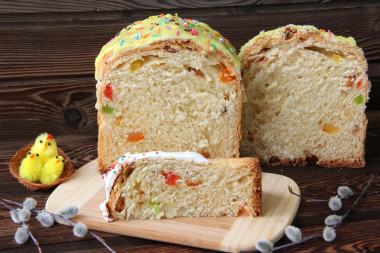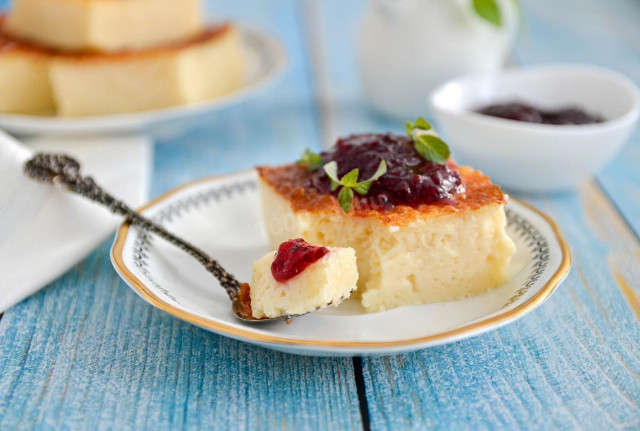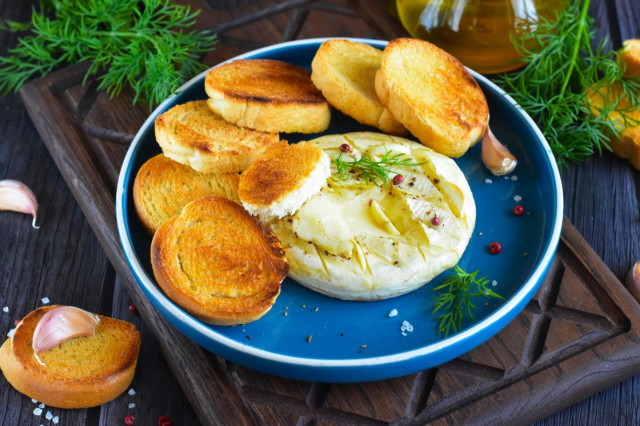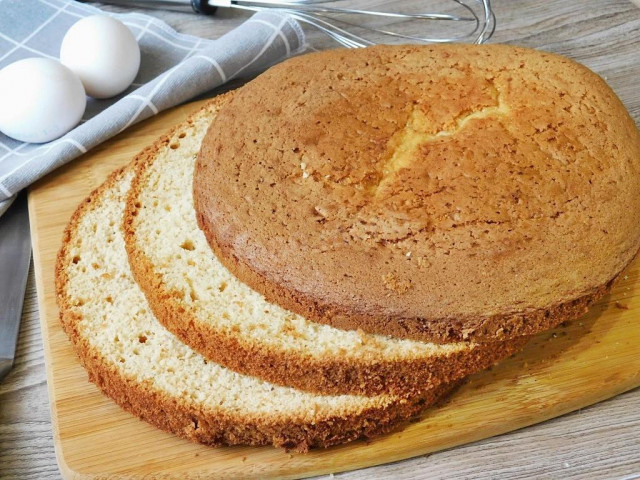Composition / ingredients
Step-by-step cooking
Step 1:
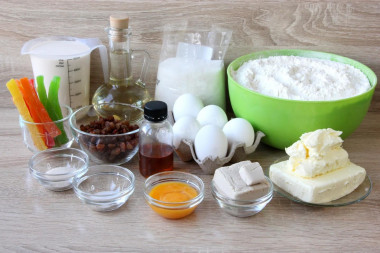
How to make an Alexandrian cake? Prepare the necessary products - all should be at room temperature. Take the flour of the highest grade. I have fresh yeast, but you can take dry, 20-25 grams. Always take the best butter, do not replace it with margarine or spread. It should be at room temperature. Raisins are light, candied fruits are orange, but it's better to take different, multicolored ones.
Step 2:
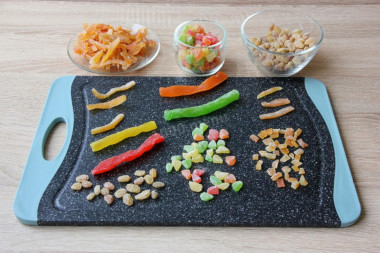
Steam the raisins with hot water for 8 minutes, rinse, remove the tails and dry. If necessary, finely chop the candied fruits. I used a mixture of candied pineapple and homemade orange peel (how to cook them, there will be a link below). Sprinkle the raisins and candied fruits with flour, mix and shake off the excess through a sieve or colander, so the candied fruits and raisins will be evenly distributed in the dough.
Step 3:
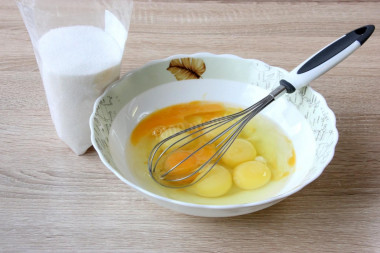
Prepare the sourdough. /It is not quite ordinary, as it does not contain flour, so it should stand for 8-12 hours /. Beat the eggs and yolks lightly with sugar, just so that the sugar dissolves.
Step 4:

Then add soft butter to the egg-sugar mixture, it is not necessary to melt it.
Step 5:
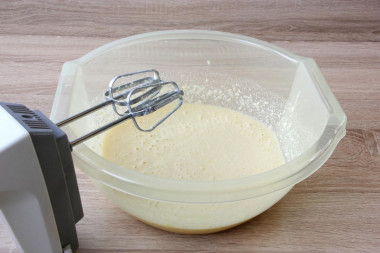
Mix the butter well until smooth with a mixer at low speed.
Step 6:
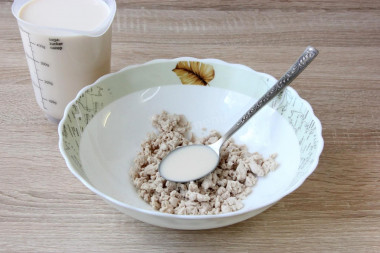
In another container, crumble the fresh pressed yeast, pour in a little warm milk / so that the finger is not hot /, rub them well. Add the rest of the milk and mix until completely dissolved. /If the yeast is fresh and of high quality, they should disperse quickly. Check the expiration date and do not use old/. Melted milk will give the cakes a beautiful shade and a brighter creamy taste.
Step 7:
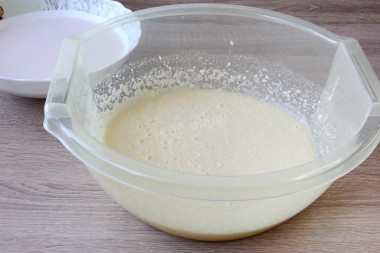
Now pour the yeast mixture into the egg mixture, mix with a mixer at low speed.
Step 8:

Cover with a towel and leave for 8-12 hours at room temperature to ferment. It is convenient to cook sourdough in the evening so that it is ready in the morning.
Step 9:
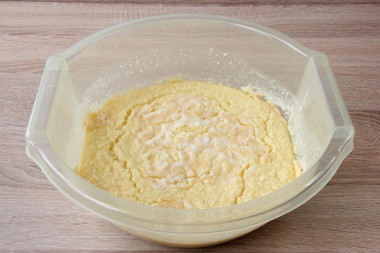
This is the look of the finished sourdough after fermentation.
Step 10:
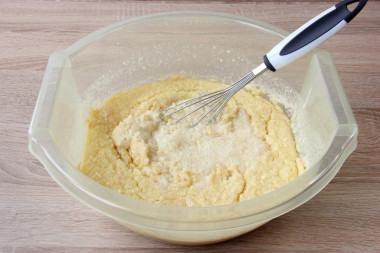
There will be an oil layer on top of the sponge, and there are a lot of sizzling bubbles under it.
Step 11:
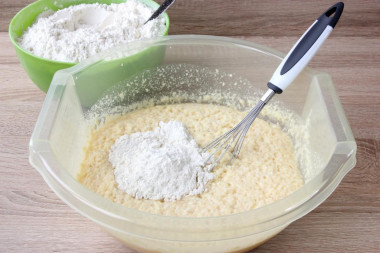
Separately, sift the flour 3 times, mix it with salt and vanilla sugar. Then add parts to the sourdough, mix everything well. I first intervened with a whisk, when it became difficult, I continued kneading with my hands. The dough should not be clogged, but tender and sticky to the hands. For relief, lubricate your hands with odorless vegetable oil, it is not necessary to score flour.
Step 12:
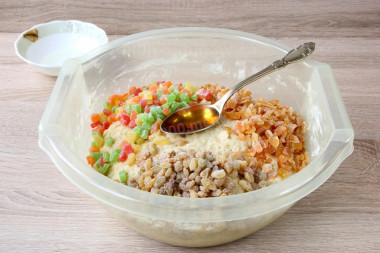
Add raisins, candied fruits and a spoonful of cognac / cognac will give the baking a special airiness/. Keep kneading, the dough will remain soft and sticky, as it should be.
Step 13:
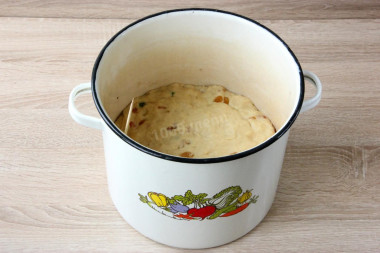
Transfer the kneading into a deep oiled container, taking into account that the dough will increase significantly in volume. Cover the dough with a greased film / I make small holes in the film / or with a towel and leave it in the heat for proofing for 1.5 hours. /I put it in the oven heated to t 35&039; and turned off/. For control, I put a skewer, the dough rises easier and smoothly.
Step 14:

As time passes, the dough will increase approximately three times. I have a bowl for kneading dough for 5 liters, I put a saucepan in 7 liters and it was just enough. The finished dough is 3,120 kg.
Step 15:

Knead the dough carefully, divide into pieces according to the number of shapes, form an even bun and fill the greased molds by 1/2 — 1/3. Cover the molds with a film and put them in a warm place for proofing for 1 hour. You can grease the molds with both butter and vegetable oil, then dust with flour and shake off the excess.
Step 16:
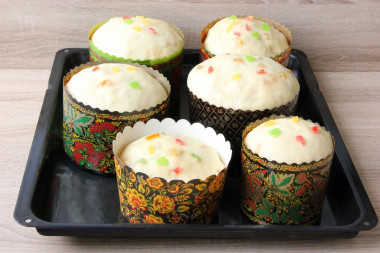
During this time, the Alexandrian dough should rise 2 times. Bake in a preheated oven at 180°C for about 20 minutes, then reduce the temperature to 160°C, cover the top with foil or parchment and bake for another 40 minutes. Do not open the oven unless necessary. Then turn off the oven, remove the foil and leave the cakes in it for 30 minutes. I bake in the top-bottom mode at an average level. You focus on your oven.
Step 17:
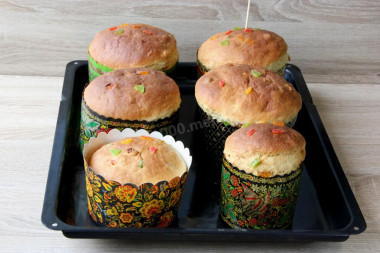
Check the readiness with a skewer, if it came out dry, then the baking is ready! Let the cakes cool down. I just cover them with a towel, I don't put them on the side. Then remove the cakes from the molds. Do not prepare the glaze in advance, as it sets quickly, so cook immediately before applying.
Step 18:

Start preparing the GLAZE. Beat the cooled whites to a fluffy foam first at low speed, then gradually adding speed. Without stopping whipping, add the sifted powdered sugar in parts. At the very end, add the lemon juice and continue to beat a little more. The glaze should have a uniform consistency, smooth and shiny. To make the glaze thicker, add powdered sugar, but a little bit at a time. You can buy ready-made glaze, as it suits you.
Step 19:

When the cakes are cool, cover them with icing and decorate with pastry sprinkles. The cakes ripen within 8 hours. That's how they will be in the section. Well-baked, light, airy, porous, slightly moist dough. Moderately sweet, with a pleasant creamy taste and vanilla aroma. The taste can be slightly changed by adding various flavors to the glaze. You can add more raisins and candied fruits to this amount of dough.
How to cook candied fruits from orange peel can be viewed
HERE
.
How to make glaze on gelatin, which does not crumble and does not crumble, you can see
HERE
.
If you are afraid to prepare glaze from raw proteins, use the recipe for custard protein cream, where proteins are brewed with syrup, undergoing heat treatment. This cream is also perfect, how to cook it, a step-by-step description with photos can be viewed
HERE
.
The number of cakes is 6 pieces, but there may be more, depending on the size of the molds.
From this amount of products, 4 large cakes d 12cm, h 13cm turned out; and 2 smaller cakes: 1 d 10cm, h 7cm; and 1 d 9cm, h 12cm.
Be prepared for the fact that flour may need more or less than indicated in the recipe. Focus not on the amount of flour, but on the desired consistency of the dough. To avoid mistakes, read about flour and its properties!
Keep in mind that everyone's ovens are different. The temperature and cooking time may differ from those specified in the recipe. To make any baked dish successful, use useful information about the features of ovens !
Caloric content of the products possible in the composition of the dish
- Granulated sugar - 398 kcal/100g
- Sugar - 398 kcal/100g
- Butter 82% - 734 kcal/100g
- Amateur unsalted butter - 709 kcal/100g
- Unsalted peasant butter - 661 kcal/100g
- Peasant salted butter - 652 kcal/100g
- Melted butter - 869 kcal/100g
- Raisins - 280 kcal/100g
- Kishmish - 279 kcal/100g
- Vegetable oil - 873 kcal/100g
- Candied fruits - 216 kcal/100g
- Ordinary cognac "three stars" - 239 kcal/100g
- Cognac - 239 kcal/100g
- Salt - 0 kcal/100g
- Lemon juice - 16 kcal/100g
- Wheat flour - 325 kcal/100g
- Egg yolks - 352 kcal/100g
- Powdered sugar - 374 kcal/100g
- Vanilla sugar - 379 kcal/100g
- Chicken egg - 80 kcal/100g
- Egg whites - 44 kcal/100g
- Candied fruit mixture - 216 kcal/100g
- Fresh yeast - 109 kcal/100g
- Melted milk - 84 kcal/100g



